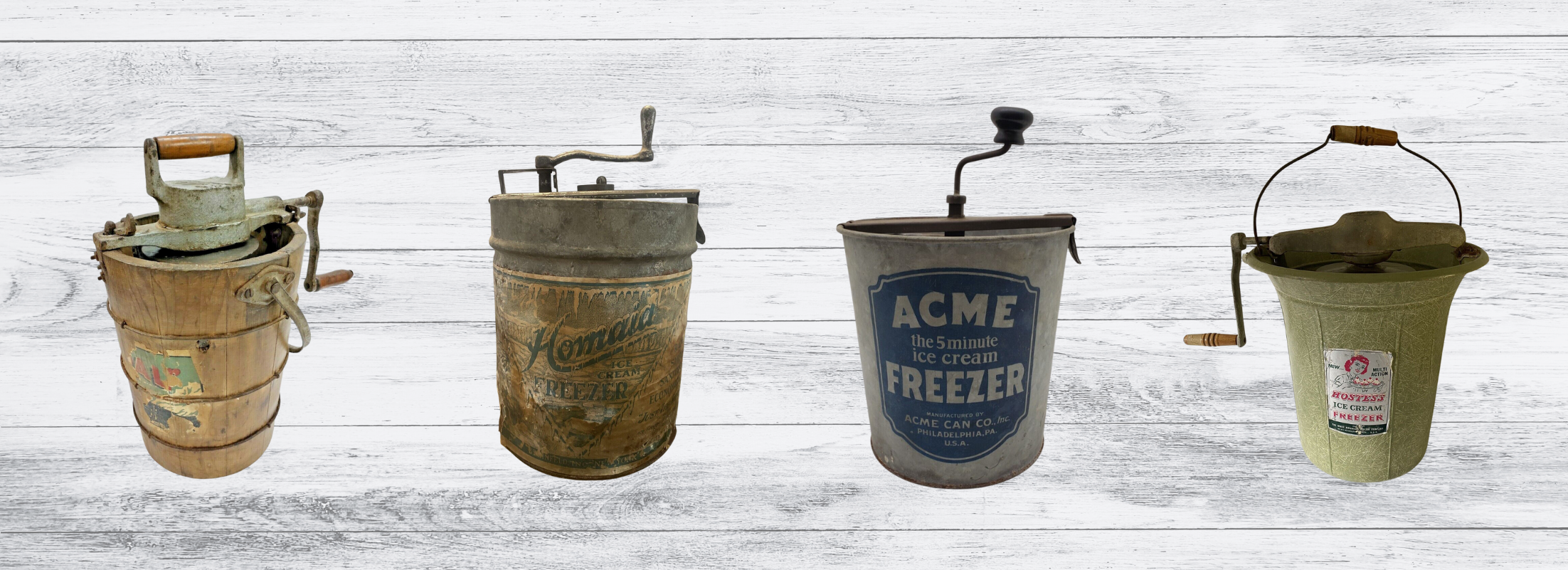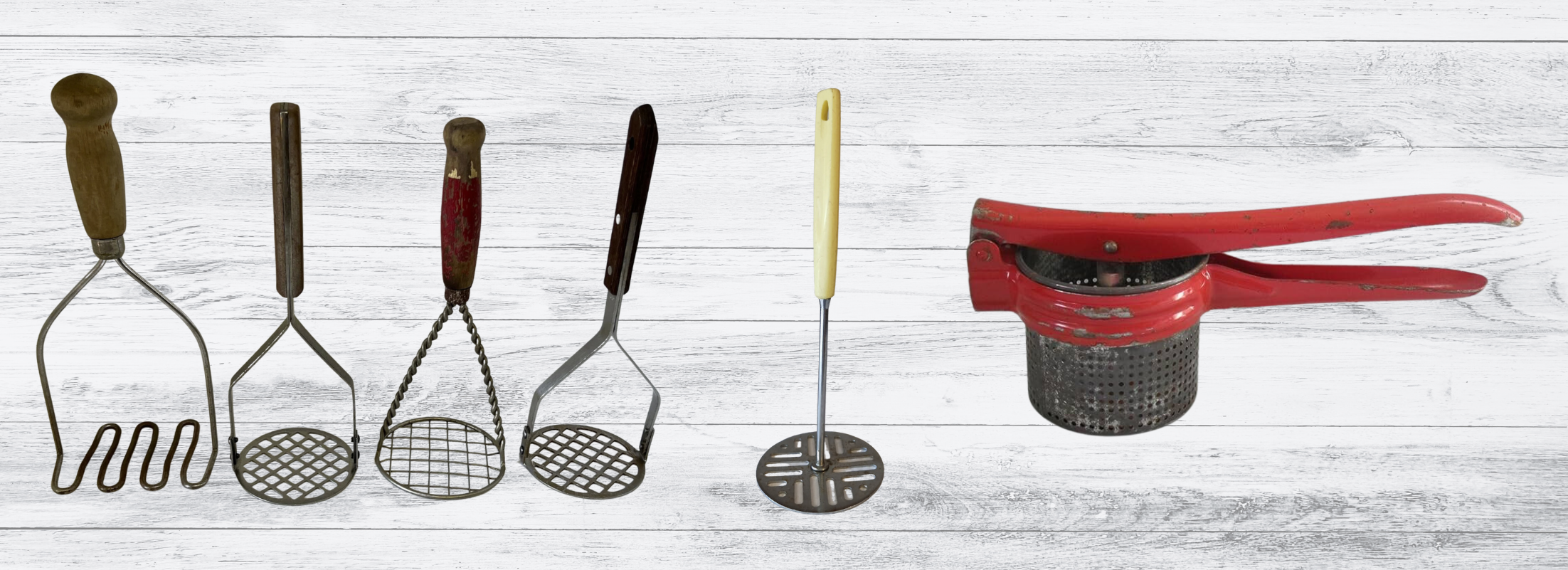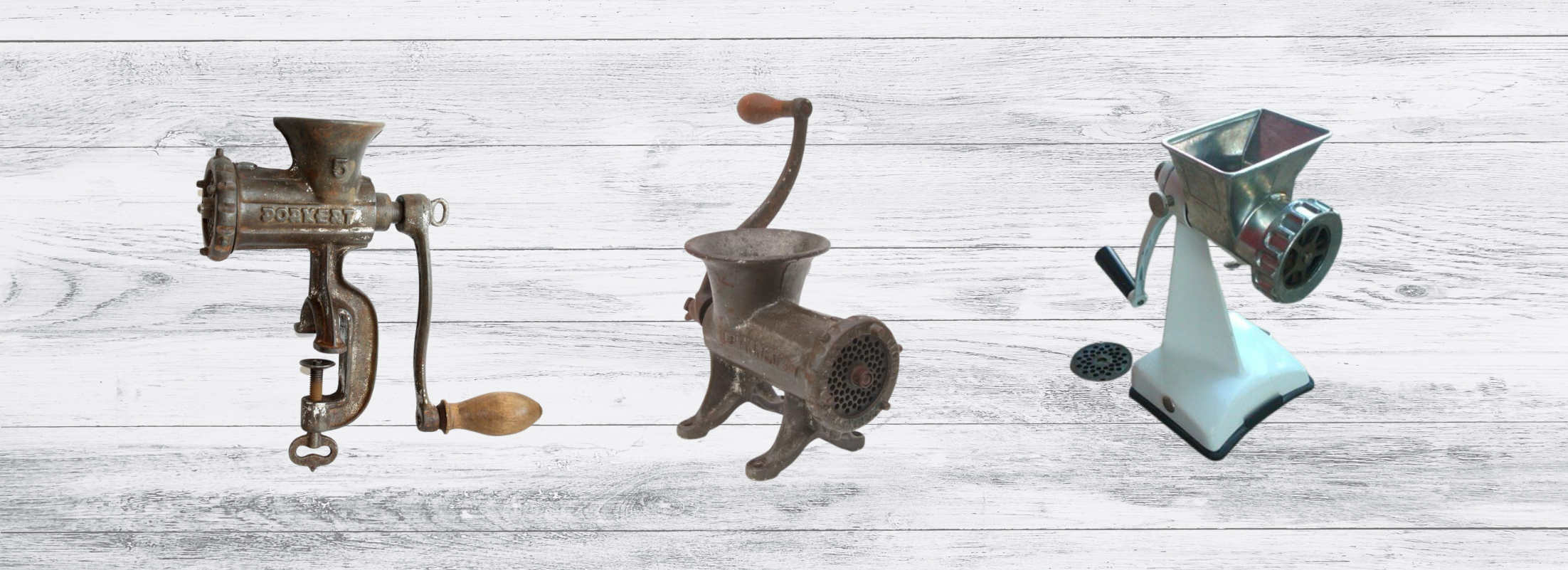Vintage Kitchen Gadgets: Quirky Tools That Stand the Test of Time
In a world dominated by cutting-edge technology and sleek modern designs, there is something undeniably captivating about stepping back in time and immersing ourselves in the nostalgia of vintage and antique kitchen gadgets.
Beyond their aesthetic appeal, vintage and antique kitchen gadgets remind us of the value of simplicity and sustainability in today's fast-paced world. In a time when convenience often reigns supreme, these charming relics offer a gentle nudge to slow down, savor the cooking process, and appreciate the little things that make a house a home.
Ceramic Tea Canister from the 1970s made by Treasure Craft
Vintage Canister Sets
Kitchen canisters have been a staple in American kitchens since the mid-19th Century and have remained popular throughout the 20th Century. Even today, many brides add a canister set to their wedding and shower gift registries. Vintage and antique canisters typically come with lids to protect against pests and maintain the freshness of their contents.
During the 19th and 20th centuries, tin canisters were popular for storing tea and coffee. They were initially sold by traveling peddlers or at country stores. Elizabeth Putnam's famous 1849 book, Mrs. Putnam's Receipt Book and Young Housekeeper's Assistant, listed tin canisters as essential for any kitchen. Prices vary significantly from $30 for a vintage aluminum set to $150 for a single well-preserved early tin canister.
During the late 19th and 20th centuries, glass and ceramic canisters were highly sought after by homemakers. These materials provided endless variations, making finding a canister set that would complement any color scheme or decorating style easy.
Enamel canisters were especially popular in the mid-20th Century and added a touch of color and style to vintage kitchens. Nowadays, they are easily found in secondhand stores, antique shops, and online. Vintage enamel canisters can be valuable collectibles ranging from $40 for a small set to over $400 for a complete group.
In the 1950s, kitchenware companies began producing canisters from high-quality plastics. Today, you can find many charming plastic canisters from the 1950s, 1960s, and 1970s at flea markets, thrift stores, and online. These plastic canisters usually represent the decorating style and colors of their decade. For instance, plastic canisters from the '50s often appear in soft pink, baby blue, and sea green. Canisters from the '70s were often avocado green, brown, or orange. Tupperware canister sets, popular in the 1970s and 1980s, are collectible. It's easy to find vintage plastic canisters for $15 to $50, but incredibly iconic plastic canister sets can sell for $100 or more.
Manual Eggbeaters
Did you know that the hand eggbeater, invented in 1856, sparked a revolution in the kitchen and beyond? Don Thornton's book, Beat This: The Eggbeater Chronicles, delves into the history and significance of this seemingly simple device. With over 1,000 patents granted in the USA alone for hand eggbeaters, it's clear that this invention was a game-changer. One patent describes the gears that make it work, using a manually cranked drive wheel with opposed gear faces and intermeshing beater elements. This gear mechanism was so innovative that it became essential for tools like the hand drill, oil drill, and automobile transmission. But it all started in the kitchen, where it allowed for the creation of commercial bakeries and even mom's homemade birthday cakes.
The combination of ingenuity and creativity resulted in the development of elegant cast iron designs, which included glass containers to prevent splatter. These thin dashers facilitated the insertion of beaters into jars and stands that held them up in a bowl. Putting a beater in a glass jar has been around since the 1880s. In addition to the rotary gear and the Archimedes slide screw, a basic spring coil used to agitate the mixture is a common mechanism in many beaters. One innovative device that stands out is the 1939 Jiffy Mixer, which combines Archimedes with a counterweight that spins a single dasher in continuous motion, like a child's toy top.
During the 1920s, only half of American households had access to electricity. As a result, water-powered glass jar eggbeaters were considered a luxury kitchen tool. These beaters connected a hose or faucet to the cap, allowing water to circulate through and turn the dashers. The water would then empty down the tube. For frugal farm cooks, the mechanism could be attached to a standard one-quart Ball canning jar for convenience.
Old Fashioned Ice Cream Makers
Ice cream was a luxury dessert for only the wealthy until the 19th Century. However, technological advancements made it more accessible to the public by the mid-1800s. The mass production of ice cream required the invention of three different machines, including the first ice cream maker.
In 1843, Nancy M. Johnson, a resident of New York, patented the original hand-cranked ice cream freezer. This ice cream maker had a center paddle and a crank with a handle. Making ice cream with this machine took 45 minutes of turning the crank. Although it may seem like a lot of time, it was less labor-intensive than using a spoon to stir.
During the 1880s, small and improved ice cream makers for domestic use became available in the market. These antique ice cream makers come with a metal inner pail and a paddle attached to the crank handle. The crank handle is placed inside a wooden bucket containing a freezing mixture of salt and ice.
Pour your ice cream mixture into the inner pail to use these antique ice cream makers. The mixture is then churned and beaten as it freezes.
Antique Toasters
Before the invention of the electric toaster, people had to toast bread on a fork over a fire or on a gas stove. Simple tools for toasting bread over flames were created in the early 1800s. The biggest challenge for early toaster inventors was finding a heating element that could withstand repeated high temperatures. In 1905, Albert Marsh solved this problem by creating "Nichrome," a filament wire made of nickel and chromium that was safe and durable when heated. It wasn't until 1919 that Charles Strite, a mechanic from Minnesota, invented a user-friendly toaster for restaurants. In 1921, he received a patent for the automatic pop-up toaster. A newer version of the Strite toaster was sold in 1926 by Waters-Genter of Minneapolis under the brand name Toastmaster. This was the first automatic pop-up household toaster that could brown bread on both sides simultaneously, set the heating element on a timer, and eject the toast once it was ready.
1930 the Proctor Electric Company created a toaster with a timing strip. Soon after, Wonder Bread started selling pre-sliced bread, and many other bakeries followed suit. This led to a surge in toaster sales by 1933, as the toasters were designed to fit the standard size of sliced bread.
The Sunbeam Corporation improved the bi-metal sensor control in the 1940s, making it responsive to the heat emitted by the bread instead of the heating element. The sensor would automatically turn off the heating element when the bread reached a temperature of 310°F (154°C).
Flour Sifters
The world's first flour sifter was invented by Jacob Bromwell® in 1819 and patented in 1930. Its popularity was due to the wire agitator's unique design, which allowed each wire to smoothly sweep the screen below it, resulting in the smoothest flour possible for consistent measurement every time. Sifting flour was necessary to eliminate any remaining seeds or husks that may have slipped through, and it was sometimes necessary to remove stray insects or lumps. Even though we usually don't encounter such issues with our flour today, sifting can still be beneficial.
The Foley food mill was one of Foley Manufacturing Company's most popular products. Foley was founded in 1926 by Walter M. Ringer, and when he introduced the food mill in 1934, it was immediately popular. This small flour sifter, which could be operated with one hand, was patented by Freeman E. Collier in 1934. In his patent, Collier explains that existing flour sifters at the time were large, heavy, poorly designed, and challenging to use. He goes on to write, "It is an object of this invention to overcome these objections and to provide an improved flour sifter that will be light in weight, yet strong and durable, well balanced and easy to use, capable of being manipulated by one hand, and in all more satisfactory than devices heretofore available." Current variations and similar products are still available for purchase.
Antique Coffee Grinders
Before the invention of coffee grinders, people in Ethiopia, the Middle East, and other early coffee-drinking countries used mortar and pestle to grind up coffee beans for brewing. However, as coffee consumption became more widespread, this method became impractical and inconsistent. In the 15th Century, people used manual spice grinders or grain mills to grind coffee instead.
In the late 17th Century, the first coffee mill, explicitly designed for grinding coffee beans, was invented by Englishman Nicholas Book. This device featured a lever mechanism that ground the coffee into a bottom drawer. The success of this invention prompted many other inventors and companies to create manual machines throughout the 18th Century. It was in the late 1800s that the American company Hobart produced the first electrical coffee grinder, leading to the modern grinders we use today.
Antique Potato Mashers
It is believed that the earliest form of a potato masher was a rock or smooth stone, eventually replaced by a hand-shaped masher made of wood. With the advent of the machine age, the wooden masher evolved into a hand-crank or machine-turned wooden mallet. By the mid to late 1800s, two modern types of mashers emerged. The most common design features an S-shaped wire flat at the bottom or a round or square wire grid flat at the bottom. This is likely the same type of potato masher that your grandmother used. Due to the space between the S-shaped wires, over-mashing potatoes is never an issue. The other kind of masher has a round disc with holes drilled into it, but it can lead to over-mashing of potatoes. In 1887 Jacob Fitzgerald and William H. Silver invented a "potato ricer." It was awarded a patent for being a "potato masher and fruit-crusher." The device was designed to crush potatoes through a sheet of small holes, like a garlic press. Today, there are modern variants available. The resulting mashed potatoes from using a potato ricer are smoother than when potatoes are crushed by hand.
Vintage Hand-Cranked Apple Peelers
Before 1864, kitchen workers and farmwives had to peel apples by hand using a knife because there were no machines or mechanical aids available to make the task quicker. David Harvey Goodell, who later became the governor of New Hampshire, invented a labor-saving device called the Lightning apple parer, which changed that. The Lightning apple parer and the company's other models are marked with "Goodell Co."
However, not all apple peelers from that time were made by the same company. Other inventors had been trying to design efficient peelers for decades before Goodell's patent. For example, Moses Coates from Pennsylvania patented an apple parer as early as 1804. Nevertheless, Goodell became known as the inventor of the apple peeler due to his efficient and popular design.
Old-Fashioned Popcorn Poppers
It's no secret that the traditional way to make popcorn is in a pot over an open flame. But with the turn of the 19th Century, there was a flurry of new popcorn inventions. Adding a stay-cool handle to a corn-popping mechanism was a Kentucky resident's invention in 1875. However, the actual boom in popcorn sales wouldn't happen until street vendors could readily transport popping devices.
Charles Cretors created a portable electric popcorn popper in 1885. His invention allowed street vendors in Chicago to roam with the crowds for more significant profits. Eventually, Cretors added a buttering and salting mechanism to the popcorn popper eight years later.
Other ways of popping popcorn have emerged, such as the air popper. The air popper hit the scene in 1970, creating extremely hot air to pop the popcorn kernels. This was an easy way to pop popcorn, and it did not involve how people made it before cooking it on the stove cooked in oil. This was a healthier way to eat popcorn and came upon a time when microwavable popcorn was also hitting the market.
Vintage Food Grinders
Karl Freiherr Drais of Karlsruhe, Germany (1785-1851) invented the food grinder, most likely in the 1830s. The design principle of Drais' grinder is almost identical to food grinders used in kitchens and butcher shops worldwide today. Levi T. Snow of Connecticut patented a food chopper in Canada in 1897 and the US in 1900.
Food grinders (choppers or mincers) have been used in North America since the 1840s and became more popular after the Philadelphia Centennial Exposition in 1876. The Canadian Encyclopedia describes them as" hollow iron cylinders containing rotary shafts with teeth that eventually evolved into a screw-like revolving shaft that cut through the meat and forces it through a perforated end plate."
Retro Juice Reamers
Reamers first came into vogue in the early 18th Century for squeezing the juice from lemons to complement food and drinks. The first reamers were all produced in Europe by major China companies like Meissen and Limoges.
The first reamer patented in the United States was in 1867. It was a one-piece, hand-held reamer. Next came a one-piece reamer (a small saucer and a cone) meant to fit on top of a glass. It didn't work out well and made quite a mess because it slid off the glass. In the 1880s, a glass rim was added to the bottom of the saucer to help keep it on the glass. Around the same time, wooden squeezers with a press action were also used. Two-piece sets with measuring pitcher bottoms and separate reamer tops emerged in the mid-1920s. The biggest boom for reamers came in 1907 due to a farmer co-op named the "California Fruit Growers Exchange."
Reamers are available in various materials, shapes, and colors. They can comprise one, two, or three pieces and have a plain or fancy design. Some reamers are also sold in sets, which include a reamer, pitcher, and juice glasses. Thousands of reamers are available in the market; some are yet to be discovered and appreciated. When finding collectibles, the best place to start looking for a reamer is your mother's or grandmother's kitchen. It could be the start of a great collection if they have a reamer that they no longer use.
Vintage kitchen gadgets provide a window into the cooking methods of yesteryear and can still serve as valuable and delightful additions to contemporary kitchens. It's important to note that genuine vintage items may be scarce and come in varying conditions. However, there are many modern replicas and reproductions of these gadgets for those who want to infuse their cooking area with nostalgia.














